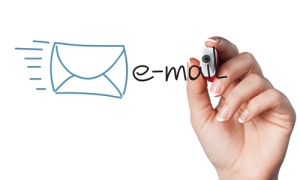
1. Sending email to a purchased list isn’t a good idea. Why? Because of a little something called the CAN-SPAM Act. This law was put into place to set rules for corporate emails, establishes requirements for commercial messages, and defines tough penalties for violators. If you don’t follow the rules, your email recipients can mark your email as SPAM. If too many of your email recipients mark your email as SPAM, your server will be “blacklisted” by SpamCop, one of the world’s leading anti-spam organizations. Once SpamCop puts your server on the blacklist, servers all over the world will block your emails. If you’re sending email from your office and using the same email server you use for day-to-day business email communications, this is going to cause you a lot of grief. Getting your server off the blacklist is difficult, time consuming and just painful. Your best strategy is to follow best practices and KEEP OFF the blacklist.
2. Sending emails to patients who agreed to receive email communication from you is a GREAT idea! People who agree to be on your email list will be more likely to open your email, more receptive to your message and less likely to mark your email as SPAM.
3. Using an Email Marketing Service provider (EMS) will help make the process easier, more effective and helps protect you from being blacklisted. There are a lot of EMS providers to choose from. Almost all of them are cloud based and offer a variety of packages with prices based on factors, such as the size of your email list, how often you send emails and features you want included in your service plan.Some EMS providers cater more to the “seasoned” email marketer, while others are well-suited for “beginners”. But before you jump online and sign-up with a provider, it’s important to outline your email marketing plan, first. Outlining the plan will help you select the right provider and the right features at the right price. Some basic features you’ll want when choosing an EMS are:
- Analytics Reporting
- Split Testing capability for subject lines
- List Management
- Template Options including mobile friendly options
Some more advanced features that can make the email marketing experience fantastic both from the administrator’s and recipient’s standpoint are:
- List Segmentation & Grouping
- Split Testing capability on all aspects of the email campaign (subject line, graphics, content, send times)
- Subscriber Insights
- Subscriber forms
- Great Customer Service & Support
4. Start with a plan. As mentioned in #3, outlining your plan should be your first step. Define your long-term goals, as well as goals for each specific campaign. Creating a frequency schedule helps your marketing plan to flow smoothly. It’s important for your schedule to stay flexible and continue to evolve after analyzing email performance data. This data may identify areas for improvement, such as the time and day you send your emails, how you word your messages or subject lines, the email address you use as the “sender’s” email, and the graphics you use in your email.
5. Don’t skip the analytics! The data never lies. Take the time to review the email performance data each and every time you send out an email. The data you’ll want to focus on will depend on the goals of the email campaign. Some examples of data covered in email campaign reports are:
- # of Emails Successfully Delivered
- Open Rate and # of Unique Opens
- Click Rate and # of Unique Clicks
- Bounce Rate (Hard & Soft)
- # of Unsubscribes
- # Abuse Complaints
- Who opened the email and how many times they opened it
- What links in the email were clicked and how many times
6. Consider a monthly e-newsletter. A monthly, bimonthly or quarterly newsletter is a great foundation to your email marketing plan. Using a newsletter format allows you to communicate a variety of topics with patients and advertise your promotions in a subtle way. You can include information about seminars, free screenings, local events, eye health articles, special promotions and discounts.
7. Email design matters. First and foremost when you’re crafting your emails, remember to stay true to your brand. Your brand should be reflected in every piece of information that leaves your practice, but be sure you maintain your brand identity in your email marketing. From the graphic design of the email, to the voice you use when creating your message, it’s important to be consistent and certain that whatever email communication you send out supports your brand.
Your emails must contain elements required to achieve the goal set for that particular campaign. Some examples of these elements are:
- Strong Call to Action
- Coupon
- Clickable link to landing page(s) with details of the promotion and a form to send a request for more information.
- Clickable link to social media pages
8. Tune-in to the right frequency for your email list. Not sending emails to your email list on a regular basis can be just as bad as sending emails too frequently. Every market/list will be slightly different as to what the magic number should be. To determine the magic number for your list, take the time to study your reports (as mentioned above). Knowledge is power.
9. Be Consistent. Once you find your “email groove”, stick to it. Incorporate change slowly so you can measure their impact (good or bad). To measure the data, you must read the data…you know where I’m going with this.
10. Have a plan when the leads start rolling-in. All your efforts will be wasted if you don’t have a plan in place for what to do when patients respond to your emails. If someone took the time to respond, it’s in your best interest to act promptly and in an organized fashion. Before you start your campaign, determine who will receive the leads, who is responsible for the next communication with the lead and what that communication entails.
Marketing is necessary to sustain and grow your practice. Whether you decide to try email marketing, or other forms of marketing, remember that marketing is time-consuming and there is cost involved both in money and resources. Like anything else in life, you get out of marketing what you put into it. Measure your results and repeat what works.
If you want to try email marketing or have tried it with not such good results, we can help. Click here to learn more about our email marketing services.
